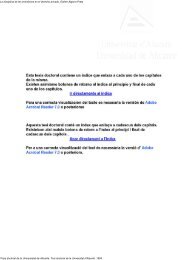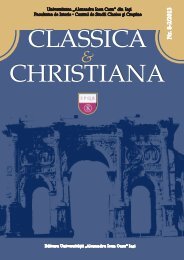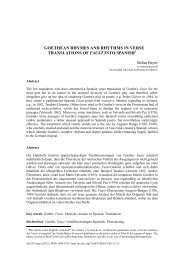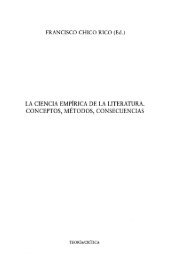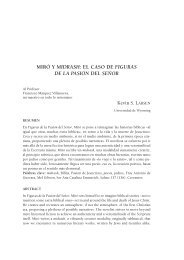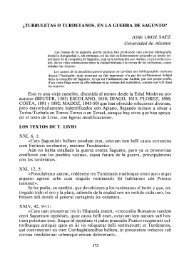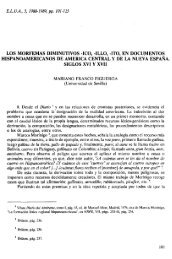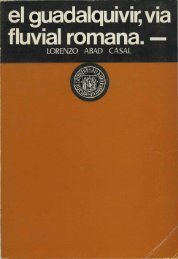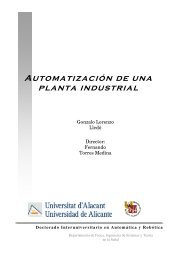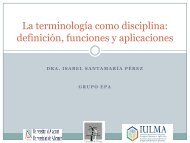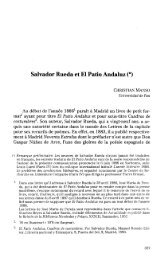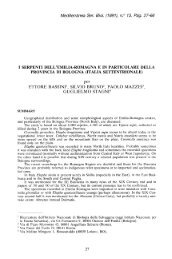ecological effects of marine protected areas empafish project ...
ecological effects of marine protected areas empafish project ...
ecological effects of marine protected areas empafish project ...
Create successful ePaper yourself
Turn your PDF publications into a flip-book with our unique Google optimized e-Paper software.
EMPAFISH Booklet no. 1 Ecological <strong>effects</strong> <strong>of</strong> Atlanto-Mediterranean MPAs in the EU<br />
Formigas islets – Dollabarat bank : <strong>ecological</strong> studies<br />
� General<br />
The fish, invertebrate and algal assemblages associated with the<br />
environments <strong>of</strong> the Formigas Bank have been studied since the late 1890s’<br />
after some expeditions to the site (e.g. Milne-Edwards & Bouvier 1899;<br />
Piccone 1899). Modern exploration, including observation by SCUBA divers<br />
and scientific collection <strong>of</strong> organisms in shallow-water habitats, started in the<br />
1970’s (Ardré et al. 1973; G<strong>of</strong>as 1989; Arruda et al. 1992; Brum et al. 1995;<br />
Ávila & Azevedo 1997). The sampling has become more regular since 1998<br />
when the underwater visual census (UVC) survey program was set up<br />
(Tempera et al. 2001a; Afonso 2002). More recently a study was started to<br />
characterise the patterns <strong>of</strong> pre-settlement dispersal and recruitment <strong>of</strong><br />
several reef species (Fontes et al. 2005). Deepwater fish fauna, the major<br />
component <strong>of</strong> the bank, that spreads down to more than 1800 m deep, has<br />
been studied by means <strong>of</strong> independent fishing cruises since the early 1990s<br />
(Menezes et al. 1998, 2000). Some effort has been in place to survey the<br />
bottoms and associated biotopes in sublittoral and circalittoral depths, using<br />
SCUBA diving, UVC, ROV and drop-down video (e.g. Tempera et al. 2001a,<br />
2001b). These studies <strong>of</strong> the bank summit have been exposing remarkable<br />
biotopes including dense Cystoseira beds, overhangs dominated by black<br />
corals, kelp forests down to unreported depths and sediments pockets with<br />
intense bioturbation. Data on multispecies interactions (including cetaceans,<br />
seabirds, seaturtles and fish) and on tuna catches, the only extractive activity<br />
authorized since the 2003 revision <strong>of</strong> the reserve protection measures is<br />
available from the POPA observers program.<br />
� Reserve effect<br />
The UVC monitoring program has shown that the shallow water assemblage <strong>of</strong><br />
the bank is highly specific and found nowhere else in the region (Afonso<br />
2002; Afonso et al. 2006). This stems from a unique mixture <strong>of</strong> demersal<br />
species typical <strong>of</strong> coastal habitats, and oceanic species, either seasonal<br />
visitors or residents, which seems to be highly dependent on increased local<br />
upwelling. Changes in this balance might be related to the recent decrease <strong>of</strong><br />
the shallow Cystoseira coverage observed in Dollabarat. This dramatic<br />
alteration is reflected on algal-associated species, such as labrids, and may<br />
confound the <strong>effects</strong> <strong>of</strong> protection. Increases in biomass and abundance were<br />
not detected in commercially important species since 1998. However, this is<br />
considered to reflect the short time past since the introduction <strong>of</strong> the stricter<br />
regulations, which prohibited all exploitation except <strong>of</strong> tuna. It is expected<br />
that the continuing <strong>of</strong> the monitoring program will allow such distinction in the<br />
future, although stricter enforcement <strong>of</strong> the regulation is required to<br />
guarantee the meeting <strong>of</strong> the reserve objectives.<br />
� Population connectivity<br />
The issue <strong>of</strong> connectivity between populations <strong>of</strong> the reserve and those<br />
residing in other banks and islands is being addressed through studies <strong>of</strong><br />
101



